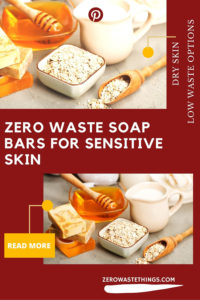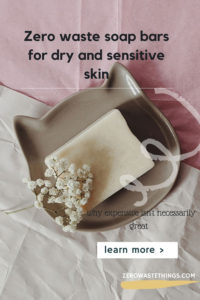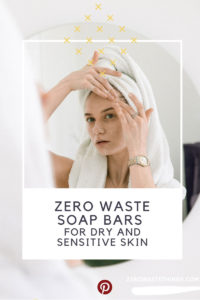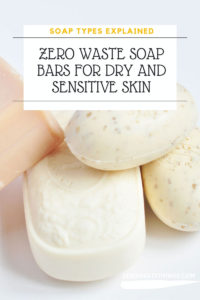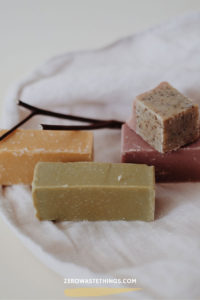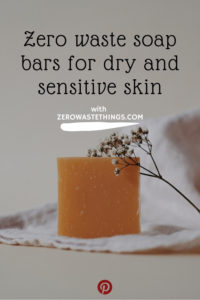I’ve made a switch to zero waste soap about 2 years ago with some dabbling into bar soaps every once in a while prior to that. I had some successes and some very odd failures.
I really wanted to make the switch, because it is one of the easier zero waste swaps for beginners, but I wasn’t sure how it will go. I wanted our bathroom to be as plastic-free as possible, but my partner wasn’t really into switching from his favorite shower wash to a zero-waste alternative.
I knew I had to choose really well if I was to switch both of us to zero waste soap.
Bar soap is actually how all kinds of soaps came in, including laundry detergent.
Initial challenges with switching to bar soap
When I was growing up, bar soaps were only used in weird public bathrooms and auto-mechanic workshops, so I wasn’t sure how it will go. My skin is pretty sensitive and shower creams were one of the luxuries I really enjoyed prior to switching to zero waste. I really liked a short pampering session after a hard day. After trying I believe it was Body Shops liquid showers gels that produced a silky rich moisturizing lather it was hard to find a good alternative.
On a side note, I have long stopped using Body Shop soaps, though claiming to be more natural and “soap-free”, some of their products contain harmful ingredients (and soap).
I stopped using conventional SLS (Sodium Laureth Sulfate) based soaps a while ago. SLS is normally the first culprit of dry, itchy skin.
To know which ingredients to avoid, look at EWG (very strict), Dirty Dozen list, and EU regulations.
It’s not only our bodies, but also, what are we letting down the drain.
The feel and texture of the soap will also depend on your water, hard, soft, chlorinated…
Standard bar soaps
The most budget-friendly version of zero-waste soap is very straightforward. You can find bar soaps in most bigger grocery stores. It’s normally in the hand soaps aisle. That is probably the most convenient solution as well, but do be careful to check if the wrap is plastic. I actually skipped those ones, because I was looking for something natural/organic.
I tried some regular drug store bar soaps before, like the DM’s Alverde organic bar soap and some PH neutral/ dermatologist recommended bar soaps and I really didn’t like them. Alverde made my skin itchy after about 1 week of using it.
Side note: The cheaper bar soaps (Savon de Marseille type) from France, especially the ones sold in tourist shops aren’t the real deal, so they will not be as luscious and moisturizing as promised. If interested, I can write a post on how to recognize the real ones, just leave me a comment below.
dr. Bronners – the soap of choice for many zero wasters
I first tried dr. Bronners, the bar, and liquid. Both were too drying for my skin. The liquid was better, but I found it wasteful since it was hard to get just the right amount. Dr. Bronners is quite watery which is fine for a bath or making DIY cleaners, not so great for direct application. It would be easier with a sponge, but I do not use them.
*I do not use dr. Bronners in DIY cleaners anymore, I’ll tell you why in another post
Low waste makeup solutions and brand recommendations when you don’t have refill options
Glycerin soap
For sensitive skin (and chlorinated water), I had the most luck with using zero waste glycerin soap. You can recognize them in the store by their “translucent color”. Do check ingredients first, because it is possible to produce classic “translucent soap”. The only problem is, they were not readily available where I live. I found it at organic or Asian grocery stores sometimes (often wrapped in non-recyclable plastic foil), but it’s not that common in Europe.
Where to buy?
I used to order all my glycerin soaps from Iherb, back when my skin was so dry, nothing else helped. They ship out of the USA and Europe, depending on the order and storage capabilities. My friend code number is NTN955 and you get 5% off your order (valid for new and old customers).
My long time favorite glycerin soap isn’t available on Iherb anymore.
DIY zero waste soap
Then I tried DIY soap. That was a major bust. My batch went moldy even after drying it for a long time and it just wasn’t that pleasant even on the second try. I wasn’t using preprepared sets and my apartment at the time had high humidity at the time, so that could have been a culprit as well. It seemed a high time (and resources) investment trying to figure out how to make soap the right way, so I retired that idea.
Artisan bar soaps
I tried some “homemade” organic soaps as well. They look so beautiful, featured in every single Pinterest board, normally have natural ingredients, they are highly customizable… They smelled good and I felt I was going in the right direction, but none that I have tried made my skin feel really good and they actually disappeared very fast (I have some tips for that as well).
I also liked African soap made out of ash which is especially good for problematic skin. Made in the traditional way is best, do try to get Fair Trade.
How to zero waste your laundry: start to finish, no nonsense or overprices products.
Zero waste soap recommendations
The solution was actually in the old school triple-milled soap.
Triple-milled soap actually lasts longer than plain soap and produces a very lush lather. Some even feel like cream on the skin. Normally there is some fragrance involved, but it’s quite natural.
Best triple-milled soaps supposedly come from Italy, Portugal, France, and England, however, do be mindful of CO2 emissions caused by shipping.
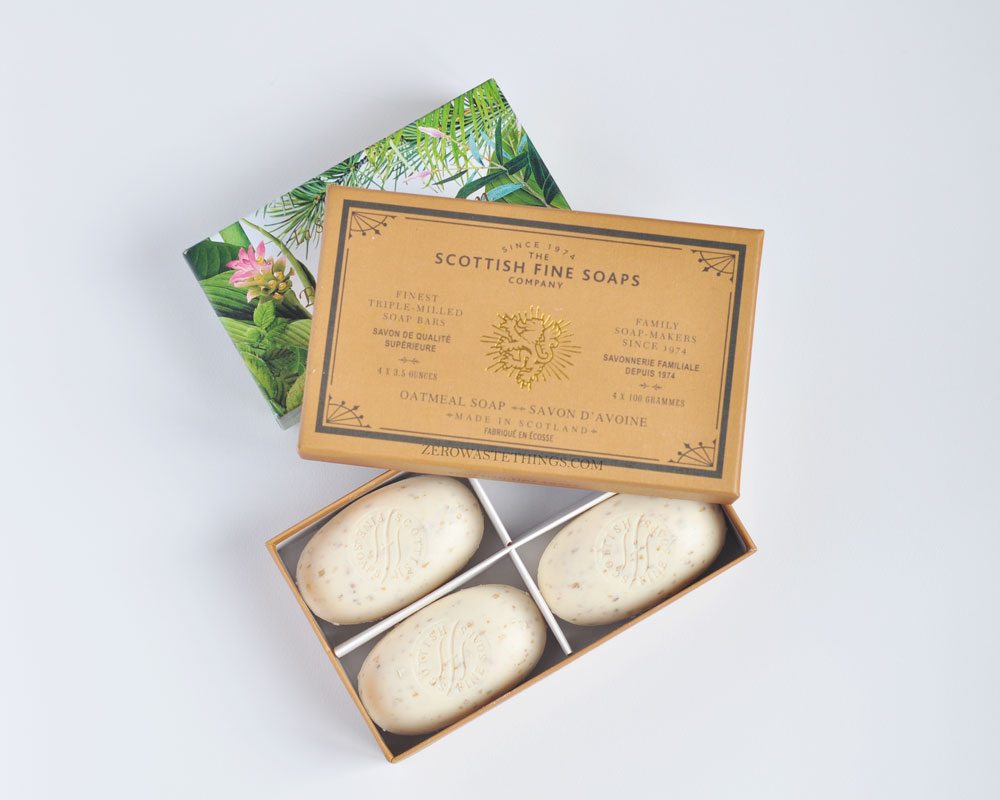
How to recognize moisturizing soaps
I have learned to recognize more luscious soaps just based on feel. The surface of creamier soaps is a bit silky and smooth, but somewhat soft if that makes sense. Regular soap is often a bit corser on the surface, a lot less smooth and almost dry feeling.
Shopping online
In my area, zero waste shops do not carry triple-milled soap, so I buy it elsewhere.
I used to order all my glycerin soaps from Iherb, back when my skin was so dry, nothing else helped. I really liked the brand Clearly Natural for glycerin-based soap bar (but it came in a thin plastic wrap). From the same store, I also got brands like One with Nature, Nubian Heritage, and Aveeno (anything with colloidal oat is great for dry skin).
They ship out of the USA and Europe, depending on the order and storage capabilities. My friend code number is NTN955 and you get 5% off your order (valid for new and old customers).
TO SHOP LOCALLY:
Etsy is a good source for smaller local producers if you are buying your soap online do try to buy it as locally as possible, however, Etsy isn’t more ethical as a company. They gobbled the German Dawanda and French A little market to gain the European market, they allow factory-made base products and like everyone else, use algorithm to favor bigger fish. I’m not saying they are bad, or that it’s wrong to shop there, but it’s good to know what we are dealing with.
Nowadays, I order from the French Beaute Prive (buying via this link gives you a 5€ voucher on your first order when you order for 15€ or more). Their prices are the best I was able to find and the products are original.
*If you are buying soap online from a non-zero-waste store, ask for shipping without plastic. They are often able to do it plastic-free if asked. Consider making a bulk purchase to save on packaging and resources.
Getting your soap to last longer
- triple milled soap lasts longest, followed by “regular soap” followed by glycerin soap
- when you first buy the soap, let it dry out a bit in a dry room (not in the bathroom)
- always use a soap stand – and you do not need to buy it. I use my metal trivet from Ikea and it’s big enough to 2-3 soaps
- make sure your soap stand doesn’t get sprayed with water
- little does go a long way: we are used to seeing big dollops in commercials but that is simply not necessary. Too much soap (or too much of the wrong kind of soap) too often will dry out your skin and strip it of its natural protective layer
- have shorter showers – it saves on water as well
- use a natural material – compostable sponge if you’d like (I don’t, but some people say it helps)
I’m happy to report, both of us are now using soap bars and there are no complaints.
However, if your skin (and/or scalp) gets irritated or really dry after a shower, look into getting a water filter (I did). You can readily order them online (not sure where I would look for them in the store, my local hardware store does not have them). No matter how gentle your zero waste soap it, chlorinated water irritates sensitive skin.
Have you tried a zero waste soap bar yet? What went well and what was a bust? Share your comments below.

